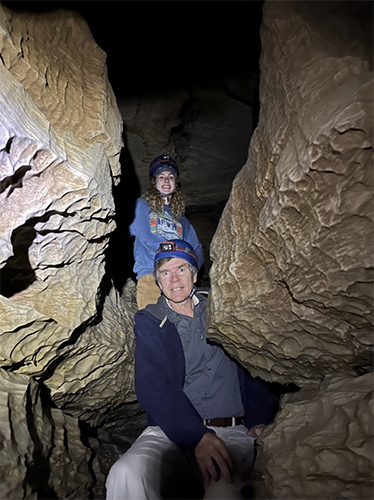WKU News
Beneath the Surface: WKU research seeks to unlock hidden climate solutions
- Eliza Marsh
- Monday, March 31st, 2025

Rain does not just nourish the earth—it also plays a surprising role in removing carbon dioxide (CO₂) from the atmosphere. When rainwater mixes with CO₂, it forms carbonic acid, a natural chemical that slowly dissolves limestone and locks away carbon. This geochemical process, happening deep underground in landscapes like Mammoth Cave National Park, remains an understudied component of climate science. A research group at Western Kentucky University is working to quantify how much CO₂ is being removed from the atmosphere through limestone dissolution.
WKU’s Crawford Hydrology Lab (CHL) led by Dr. Chris Groves, seeks to better understand the role of karst landscapes in global carbon cycling. Other members of this ongoing project include Lee Anne Bledsoe and Autumn Singer, staff members at the CHL; LJ Risteski, a CHL graduate student; Rick Toomey, research coordinator for Mammoth Cave National Park; and Marcus Key, program lead for Mammoth Cave’s Science and Resource Management Program. The team also includes future Hilltopper Kathryn Harris, a senior at Bowling Green High School, who is assisting with the project.
Senior Ava Lich joined this project in 2024. As a recipient of the Mahurin Honors College/Crawford Hydrology Lab Environmental Research Fellowship, Lich collects and analyzes discharge data from Great Onyx Cave, one of the park’s most isolated and pristine cave systems.
Limestone landscapes, or karst systems, play a role in regulating atmospheric CO₂. When rainwater absorbs CO₂, it forms carbonic acid, which reacts with limestone and dissolves the rock. “CO₂ gas—there’s only a small amount in the atmosphere by proportion, but it’s very effective at warming the atmosphere,” Groves said.
Groves, who also serves as a University Distinguished Professor of Hydrology, explained that the global carbon cycle operates like a bank account. “If you have a checking account and say, ‘Okay, how much am I going to have in my checking account in a year?’ Then what do you need to know? You need to know how much is in there now. You need to know what’s coming in, and you need to know what’s going out,” he said. “It’s very much the same with CO₂ in the atmosphere. The question is, what are the ins and what are the outs?”
While CO₂ emissions from human activities like burning fossil fuels are well-documented inputs, the natural removal processes—such as limestone dissolution—are less understood. “There is a very, very high need to better measure what all the ins and outs are,” Groves said. “And that’s what this research is working toward.”
By studying how limestone dissolution influences atmospheric CO₂ levels, Lich’s work contributes to ongoing efforts to measure these processes on a larger scale. “This research is really important," Lich said. "It shows that having these protected areas, having lands like Mammoth Cave National Park, is really, really important because it contributes to the natural carbon dioxide removal from the atmosphere.”
Lich’s research focuses on quantifying this process in Great Onyx Cave, where the underground Cascade River actively carves through the limestone, continuously dissolving it.
“You can track how much carbon dioxide is removed from the atmosphere by limestone dissolution because that carbon dioxide is being pulled from the atmosphere to make that carbonic acid,” Lich explained.
But measuring CO₂ removal is not as simple as taking a sample—it requires tracking the movement of water through the cave and correlating it with limestone dissolution rates.
To understand how much CO₂ is being removed, Lich measures discharge, or the volume of water flowing through the Cascade River. Lich and other members of the CHL installed a barrel weir, a large drum that collects water from an underground waterfall and automatically measures water levels.
“We have a barrel that is catching all of the water from a waterfall, basically,” Lich explained. “We’re measuring how much water is flowing through the cave… and that is how you can calculate how much CO₂ is being removed from the atmosphere.”
Lich plays a significant role in this project by calculating the discharge based on the water height in the barrel. Turning these measurements into meaningful data requires mathematical modeling and computational analysis.
“I had to teach myself how to do computer programming for this project,” Lich said. By analyzing the relationship between precipitation and water discharge, she found a strong correlation between rainfall and CO₂ removal. “When I compare the discharge measurements to the weather data, everything lines up. You can see a sharp increase in discharge after it starts raining. And it lines up with other data that’s been collected in the past, which makes me hopeful that my measurements are accurate.”
The Great Onyx Cave research site provides an ideal environment for this study due to its remote location and minimal human disturbance. “It’s in the middle of nowhere—like 20 to 30 minutes from the nearest gas station,” Lich said. “And it’s an active cave, meaning limestone is still dissolving, and formations are still being made. We wouldn’t be able to do this in a dry cave where nothing was happening.”
While Lich’s research is focused on a single cave system, its implications are much broader. By improving quantitative measurements of CO₂ removal in karst landscapes, her work contributes to global climate research efforts.
“There’s a balance to the ecosystem, and you can’t really throw that off,” Lich said. “Everything plays a part, and everything makes a difference.”
Lich hopes that her findings could help policymakers recognize the role of protected lands like Mammoth Cave in mitigating climate change. She also had the opportunity to speak to state legislators and discuss her research at the 2025 Posters at the Capitol showcase.
“I would really like to show our politicians that our protected lands are very important,” she said.
Lich’s work will not end when she graduates. Though she may be stepping away, the Crawford Hydrology Lab will continue the larger project. Student researchers and staff at WKU will build on her discharge measurements to provide a more complete picture of the process.
Lich says the skills she has gained throughout this project have opened her eyes to more sides of geology and hydrology and helped her determine what she wants to do after she graduates.
“There’s been a lot more engineering in this than I thought,” she said. “I work for Extract Process Solutions, and I work under a chemical engineer. So, doing that engineering through my research project has really helped me get a leg up in my career. I’m going to work full-time for them after I graduate.”
For students interested in environmental research, Lich emphasizes the importance of networking and asking for help. “All of the challenging parts of this project have been solved just by communication and by asking for help,” she said. She credits the Crawford Hydrology Lab, the Mahurin Honors College, WKU's Department of Mathematics and the WKU School of Engineering and Applied Science for helping her turn a complex project into something meaningful.
--
To learn more about a degree in Biology at WKU, visit https://www.wku.edu/biology/
To learn more about a degree in Geological Sciences & the Crawford Hydrology Lab at WKU, visit https://www.wku.edu/geology/
To learn more about a degree in Mathematics at WKU, visit https://www.wku.edu/math/
To learn more about the Mahurin Honors College at WKU, visit https://www.wku.edu/honors/

